|
|||||||||
|
ARTICLESTrapped behind Walls: Ming Writing on the Wall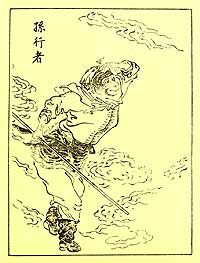 Fig. 1 Sun Wukong, Monkey, from the 1888 lithographic edition of Xiyou ji. Even though Chinese states and dynasties built long boundary walls for defensive purposes over two and a half millennia, Ming dynasty (1368-1644) alarm at the resilience of the Mongols and other northern peoples, as well as fears of containment and encirclement, occasioned also by coastal pirates, gave rise to a preoccupation with national defence and an intensive wall building unprecedented in its scope. For the first time the historical Great Walls and present policy became the concern of Chinese historians and political figures, while the walls formed a leitmotif even running through vernacular literature. 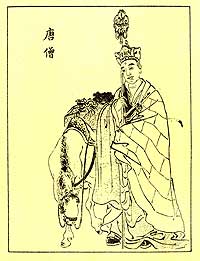 Fig. 2 Sanzang (Tripitaka), Monk of Tang, from lithographic edition of Xiyou ji published in 1888. Xiyou bu, for example, was a novel published in 1641, on the eve of the collapse of the Ming dynasty, that echoes this 'national' concern.[1] Attributed to the young scholar Dong Ruoyu (also known as Dong Yue, 1620-1686),[2] this work recounts an episode that could not have happened in the novel it parodies—Xiyou ji (Journey to the West, also known in English as Monkey). In Dong's work Monkey is the protagonist, however he is no longer the heroic warrior who successfully battles demons and clears the way for Tripitaka on his western pilgrimage. (Figs. 1 & 2) This time around Monkey is cast under a spell and placed within a fractured version of Chinese historical time and space, hemmed in by mazes, walls, barriers, gates and mirrors. In this constricting realm he moves between his own past, present and future. (Fig. 3) Monkey cannot explain to himself the 'New' Tang empire, within the walls of which he is trapped and condemned to act out various historical roles, as the victim of the spell placed on him by the demonic Mackerel Fish. In this late-Ming work, Monkey is the victim of 'delusions' triggered by sexual and political anxiety. 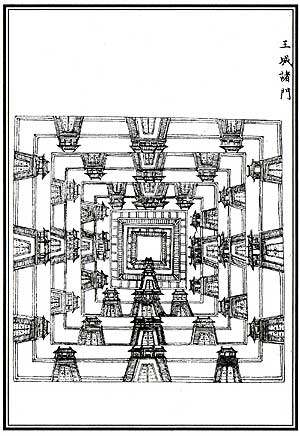 Fig. 3 'The many gates of the royal city' (Wangcheng zhumen), an illustration without attribution from the voluminous Ming dynasty encyclopaedic collection of Chinese writings Yongle dadian. Reproduced in: Chen Tongbin et al ed., Illustrations of ancient Chinese architecture (Zhongguo gudai jianzhu da tudian), Beijing: Jinri Zhongguo Chubanshe, 1996, vol. 2, p.1185. Xiyou bu offers a transgressive reading of Chinese history. Its settings and plot obey none of the rules of conventional history or 'common sense', in a manner suggestive of more contemporary fiction. In one episode in the novel, Monkey, who has been transformed into a Tang dynasty court beauty, is wooed by the King of Qin, later to become Qin Shihuang, an emperor from another era whose follies in erecting a tomb the size of a mountain and constructing massive walls Monkey derisively holds up to ridicule. In another chapter, Monkey sadistically indulges in the pleasure of acting as the prosecutor at a trial in hell of the Song dynasty 'traitor' Qin Hui (1090-1155), (Fig. 4) who is held to have negotiated a secret treaty with the forbears of the Manchus, the Jurchen Jin dynasty. The Jurchen succeeded in penetrating China's earlier walls and conquering much of the north, bringing misery to the southern Chinese and weakening the Song dynasty for the final onslaught of the Mongols. At the imaginary trial in hell, Monkey urges Yue Fei (1103-1142), the 'patriotic' general and historical figure who fought the Jurchen but who was betrayed by Qin Hui and put to death, to savour a draught of Qin Hui's blood. 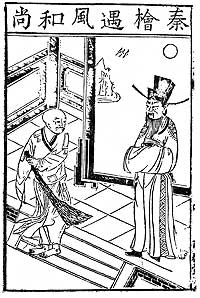 Fig. 4 'Qin Hui encounters the Monk of the Wind' Woodblock illustration from the anonymous Ming romance Tale of the Eastern Window (Dong chuang ji), fasc. 2, Ming Wanli period (1573-1619) edition, published by the Tang of Fuchun Hall, Jinling Shusi. In Dong's novel, the condemned Qin Hui has no sooner been led away by a horde of hell's minions than Monkey finds himself outside a large gate set within a massive wall called Yumenguan (Jade Pass), (Fig. 5) the name of one of the major frontier passes in the Han dynasty north-western walls that signified the limits of the 'Chinese' world in classical poetry, although in the novel the Jade Pass seems to have been assigned to a location in Shandong. 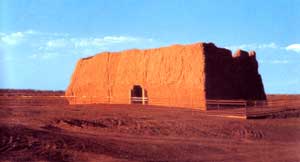 Fig. 5 Photograph of the remains of Jade Pass near Dunhuang, Gansu province. Outside the gate Monkey notices that his body is exuding a rank odour, and, after much speculation, he concludes that the stench is coming from the 'Tartars' (Chinese: Tata), a general term in the Ming dynasty for Mongols, but later sometimes also applied to the Manchus and other northern ethnic groups, massed on the other side of the wall. ('This is the wall that separates us from the Tartars. Walk on for a bit and your whole body will stink', Xiyou bu, pp.96-97.) From Chinese history, as rendered in popular accounts or vernacular literature, Dong Ruoyu takes stock characters (Qin Shihuang, Qin Hui, Yang Guifei and Yue Fei) and familiar props (the great walls) and sets them within a constantly shifting scenario that represents significant innovation in Chinese fictional narrative techniques. The political anxiety is of particular interest. Monkey is troubled by a demon, the name of which is a homophone of Qing. The novel bristles with imagery and place names constructed from homophones of the word qing. For example, in the Qingqing Shijie (Evergreen World) the author presents an allegory of the 'Qing', the state proclaimed by the Manchus in north-eastern China in 1636, eight years prior to their establishment of a dynasty in Beijing, and only three years before the novel was first printed. Comparative literature perhaps highlights differences between literary traditions more than it can ever achieve its avowed ideals of stressing shared concerns and themes, but here mention can be made of two works of central European literature that evoke images of Qin Shihuang as the ultimately doomed tyrant coupled with the great wall theme: Franz Kafka, Beim Bau der Chinesischen Mauer ('The Great Wall of China', written in 1917) and, the theatrical farce, Max Frisch, Die Chinesische Mauer ('The Chinese Wall', 1947). The latter work is, however, also of more than passing interest in relation to Xi you bu because Frisch, like Dong, brings to the stage figures from various disconnected periods of history to make his rhetorical points on political power and hubris, a device similar to that Dong Ruoyu indulges. 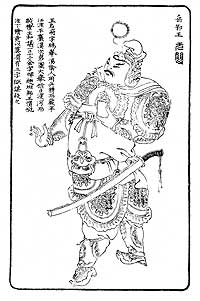 Fig. 6 Illustration of Yue Fei from the mid-Kangxi period woodblock edition of Wushuang pu. A trans-dynastic image of the 'Great Wall' of China is presented in this novel as a folly created by a deluded tyrant that failed to fulfil the purpose for which it was constructed, namely to protect China from barbarians beyond, whose presence is so near that we can 'smell' them and who can be admitted into China by the treachery of a single individual such as Qin Hui, despite the best efforts of valiant patriots, such as general Yue Fei, (Fig. 6) to keep them at bay. The leitmotif of walls through the novel serves to reinforce the reader's appreciation of Monkey's sense of entrapment. Whether or not this aspect of the novel expresses the political position of the author regarding issues of statecraft, national defence and the role that Great Walls can play in safeguarding dynastic territory from aggression or conquest is hard to ascertain from a work which is clearly fantasy and in which the protagonist Monkey's ideas are at best delusional. However, Dong Ruoyu had a demonstrated intellectual interest in Great Walls. Although best known for this novel, Dong Ruoyu also compiled a study of the Warring States period titled Qi guo kao (Research on the seven states).[3] Qi guo kao, included in the Siku quanshu collection, is a work of general history not belonging to the genres of orthodox chronicles, local gazetteers, and treatises on government policy or statecraft, and also laying outside the tradition of annotation, which discussed the 'great walls' of the ancient Warring States in systematic detail and at length. Dong Ruoyu's work drew on China's fine traditions of scholarship in historical geography, first developed in the Eastern Jin dynasty by Li Daoyuan, but was also part of the intense debate in the Ming dynasty on the Great Walls. There was interest in the history of border defence (bianfang) in the Ming dynasty, faced with incursions by Wo pirates, Mongols and, eventually, the Manchus. By the mid-16th century the defensive line of the Great Walls (referred to in the Ming as the 'nine borders', jiubian) that linked together the various regional military commands (zhen) of both the army and the divisions of the national guard (weisuo) was proving dysfunctional. This crisis prompted scholars to examine the historical geography of the border area, especially in the Jiajing (1522-1566) and Wanli (1573-1620) reign periods, and later. In his Studies of Chinese geographic maps and publications (Zhongguo dili tuji congkao),[4] Wang Yong lists 388 works in this category produced in the Ming, and he excludes from the list historical works, collections of memorials, collectanea, gazetteers of provinces, prefectures and counties in northern border areas, and military studies (bingshu). The recruitment of civilian graduates by the military bureaucracy was a factor that resulted in this flourishing of historical geographic studies of Chinese border defences. Moreover, military studies also became popular among educated persons, and martial arts attracted a wide following. This writing on the historical geography examining border defences among scholars is generally regarded as an attack on government defence policies and measures, and their failure, implicit in which was an attack on endemic political corruption. Such writing spurred on the development of historical writing and continued to exert an influence into the Qing dynasty. In Qi guo kao, Dong Ruoyu discusses, in separate fascicles, the seven last surviving major warring states (Qin, Qi, Chu, Zhao, Wei, Han and Yan) prior to their amalgamation by Qin in 221 BCE. In each fascicle he examines the political system, ritual practices, geography, economy and other aspects of a particular state and, significantly, devotes a section in each to the 'Great Walls' (which he terms changcheng) built by each of these early states, drawing on material from Shi ji, Zhanguo ce, Han shu, the philosophers and heterodox histories, and also including material from what we today classify as proto-fiction (xiaoshuo) and fables (yuyan). Dong exhausts what ancient books contained on the pre-Qin great walls, in the manner which characterizes ancient Chinese collectanea (leishu). Despite the fact that Dong Ruoyu could not benefit from the exegetical and historical rigour applied to ancient texts by the later Qian-Jia school of historical scholars such as Qian Daxin (1728-1804) and Zhang Xuecheng (1738-1801), Qi guo kao is part of the fine traditions of ancient geographical and historical writing in China. The opening passage of the section devoted to the walls of Qin is interesting because most of the sources Dong Ruoyu cites remain the subject of debate to the present day. Dong cites Wang Yinglin: 'King Zhao of Qin conquered Yiqu. Qin acquired Shangjun in north-western Long and, to keep the Hu [people] out, built a great wall (changcheng)'. [6] Dong conludes that 'the building of the walls was not initiated by [Qin] Shihuang'.[7] Wang Yinglin was writing in the Southern Song dynasty (1127-1279) and, although many of Wang's commentaries were eschewed by the school of exegetists of the Qianlong (1736-1795) and Jiaqing (1796-1820) periods, Wang is also still discussed by Great Wall scholars writing about the Qin walls today. Delineating the Qin walls and the extent to which they were built from scratch, or afresh, by Qin Shihuang or were a legacy acquired from the states Qin conquered is crucial in evaluating Qin Shihuang's rule. Dong Ruoyu later goes on to quote Beibian beidui: 'The Qin walls (cheng) were mostly built on those of Yan and Zhao. The Yan walls began in Zaoyang and extended to Xiangping and Liaoyang. Zaoyang is in the Shanggu region, Xiangping is Liaodong county, and Liaoyang is the northern bank of the Liaoshui [River]. All marked the frontier between the Yan state and the Hu people, and it was here that [Yan] constructed walls. The walls of Zhao ran from the Dai district to Gaoque in the west. Dai was the du [metropolis or capital] of Yanmen, and Gaoque was on the upper reaches of the Beiliuhe [River] in the western Yinshan mountains of Lingzhou. The territory of King Wuling of Zhao was in Yun and Dai, and so his walls ran along the Western bank of the Yellow River, which marked the boundary of his state. When Qin eliminated all rival six states, he united all the states in one. Qin's territory extended from the area north of Shangjun and Beidi in the west to the area west of Liaodong in the east. As a result of [the Qin general] Meng Tian's campaign, Lintao marked the westernmost extent of China and, in the north, Liaodong marked China's easternmost frontier, a distance from east to west of more than ten thousand li'.[6] 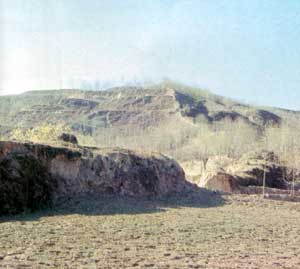 Fig. 7 Qin Great Wall site in western Lintao county, Gansu province. Little survives of any of these walls today, although remains of the Great Wall at Lintao have been identified by archaeologists. (Fig. 7) The location of most of the places Dong Ruoyu cites have been the subject of debate since his time. The sources and the understanding of the Great Walls of Qin and the other Warring States and of their extent, as presented by Dong Ruoyu, are also still disputed, even though Qin's walls have, in the three and a half centuries since Dong Ruoyu, been examined by teams of archaeologists and discussed by many more historians. Nevertheless, ancient walls in today's Fuxian county, Shaanxi province, which were only surveyed for the first time by archaeologists in 1988-1991, have been identified as the 'Shangjun walls' (Shangjun sai) on which King Huiwen of Qin began construction work in 324 BCE. It is surprising then to read some of the latest scholarship on the trajectory of the Great Walls and to find Dong Ruoyu's selection and reading of sources largely confirmed by some of the latest scholarship, as can be seen from the following map (Fig. 8) prepared by Xin Deyong to confirm his very detailed study of the Qin walls and administrative divisions.[7] 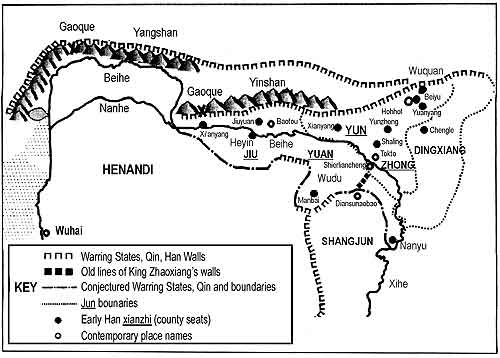 Fig. 8 Map showing political divisions in the Hetao (Ordos) region and adjacent areas during the late-Qin and early-Han dynasties. This geographical reconstruction is the work of Xin Deyong, Wenshi, 2006:1, p. 59. The late-Ming interest in the history and geography of the Great Walls echoed contemporary concerns, and often implied a critique of contemporary government defence policies. The Ming debate on the Great Walls encompassed solid scholarship, but also provided great scope for myth makers, imaginative historians and authors of vernacular literature. [BGD] Notes:[1] Xiyou bu, Hong Kong: Shangwu Yinshuguan, 1958, p.150. For a translation, see The tower of myriad mirrors: a supplement to Journey to the West, translated by Shuen-fu Lin and Larry J. Schulz, Berkeley, California: Asian Humanities Press, 1978. [2] The authorship of Xiyou bu has been debated ever since the novel came to the attention of May Fourth scholars of vernacular literature. One body of recent scholarship suggests that Dong Sizhang (1586-1628), Dong Yue's father, rather than Dong Ruoyu, was the author of Xiyou bu, but the major evidence offered by those who question Dong Ruoyu's authorship is that a man of only twenty could not have written a novel which is a political and sexual parody. [3] Qi guo kao by Dong Yue (Dong Ruoyu) has been published in a modern punctuated version, Beijing: Zhonghua Shuju, 1956, 2nd ed., 1998. [4] Shanghai: Shangwu Yinshuguan, 1956. [5] Dong Yue (Dong Ruoyu), Qi guo kao, Beijing: Zhonghua Shuju, 1956, p.116. [6] Idem. [7] See: Xin Deyong, 'Qin Shihuang sanshiliu jun xin kao, shang' (The thirty-six prefectures in the time of Qin Shihuang: A new approach, [1]), Wenshi (Beijing: Zhonghua Shuju), 2006:1, pp.21-65. |